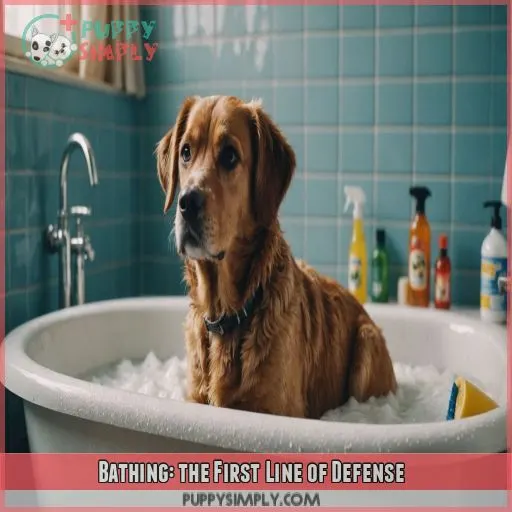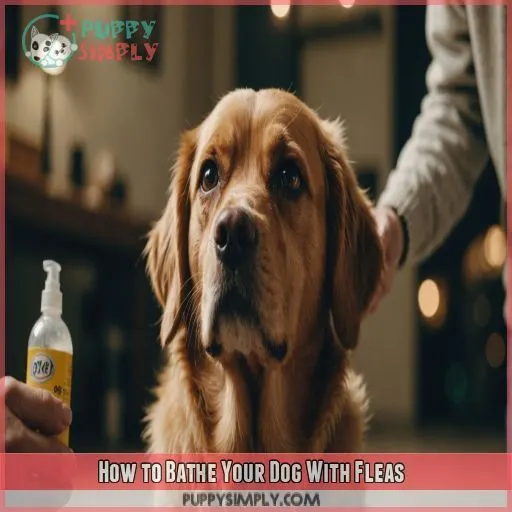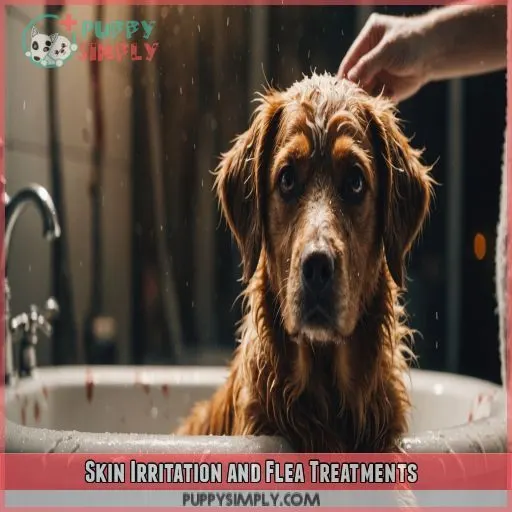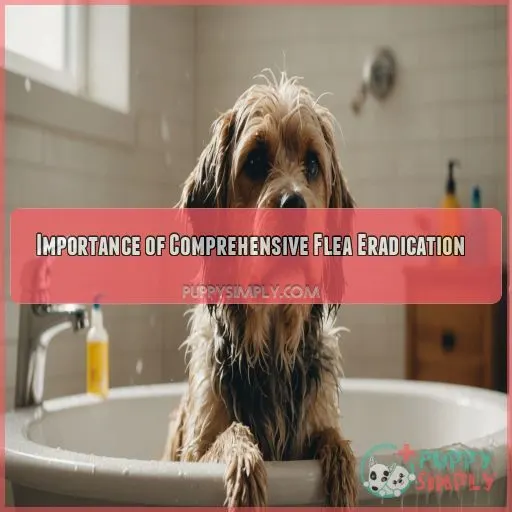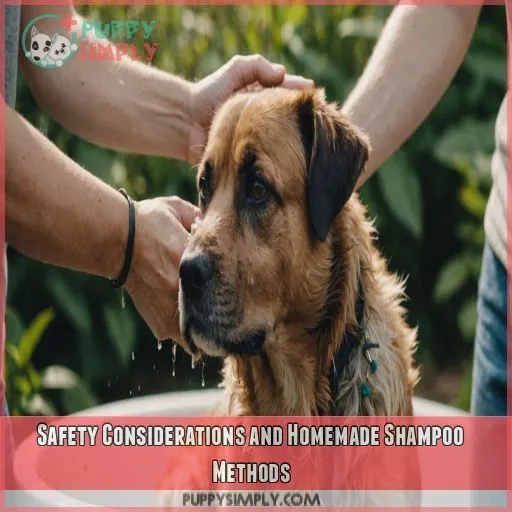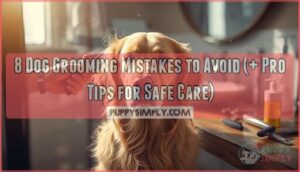This site is supported by our readers. We may earn a commission, at no cost to you, if you purchase through links.
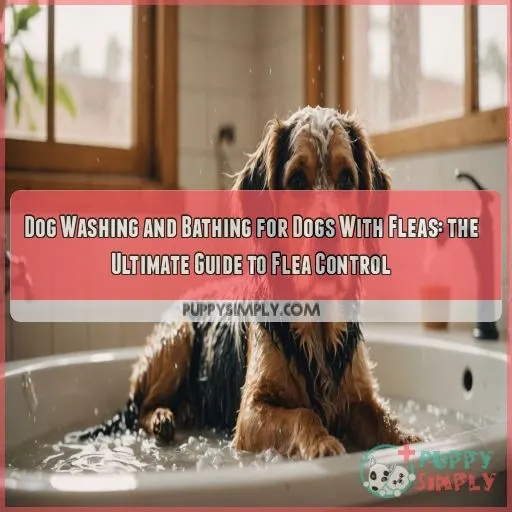
Just lukewarm water, or water with a mild soap, can help. If you’re thinking of using a flea shampoo, chat with your vet first as these can be harsh on your dog’s skin.
You’ll want to brush your dog’s coat before bathing to remove loose fur, and choose a comfortable location like a tub or outside. Make sure the water is lukewarm, and use a gentle, dog-specific shampoo.
Rinse thoroughly, and if your dog has skin irritation, soothe it with aloe vera gel or calendula cream.
Want to know more about how to tackle fleas?
Table Of Contents
- Key Takeaways
- Fleas 101: Life Cycle and Habitat
- Bathing: the First Line of Defense
- How to Bathe Your Dog With Fleas
- Skin Irritation and Flea Treatments
- Importance of Comprehensive Flea Eradication
- Safety Considerations and Homemade Shampoo Methods
- Frequently Asked Questions (FAQs)
- Will washing my dog get rid of fleas?
- What should I bathe my dog with if he has fleas?
- Do dog groomers wash dogs with fleas?
- What kills fleas immediately on dogs?
- How often should I bathe my dog?
- How can I tell if my dog has fleas?
- What should I do if my dog has a severe reaction to the shampoo?
- How can I prevent fleas in the future?
- Are there any natural alternatives to commercial flea shampoos?
- Conclusion
Key Takeaways
- Bathing your dog in lukewarm water or using a mild soap is a great first step to tackle fleas. It’s like hitting the reset button!
- Consult your vet before using a flea shampoo, as these can be harsh on your dog’s skin. A gentle, dog-specific shampoo is best.
- The flea life cycle includes eggs, larvae, pupae, and adults, and they love to set up camp in your dog’s bedding and your carpet. So, it’s important to clean and treat your home too.
- A flea-free environment is key to a happy, itch-free pup. Vacuum regularly, wash bedding, and use flea-deterring products to keep those pesky parasites at bay.
Fleas 101: Life Cycle and Habitat
First, let’s take a closer look at the life cycle and habitat of these pesky parasites. To win the war against fleas, you need to know your enemy.
How Long Does the Flea Cycle Take?
Fleas are pesky critters with a four-stage lifecycle:
- Eggs,
- Larvae,
- Pupae, and
- adults.
The entire cycle can take a few weeks in ideal conditions, but in less favorable environments, it may stretch to a few months. During this time, your home becomes a flea motel, with eggs, larvae, and pupae setting up camp in your dog’s bedding and your carpet. So, while adult fleas are your pet’s unwelcome travel companions, their offspring are busy making your home their own.
Where Do Fleas Thrive?
While adult fleas make your dog their home, their eggs, larvae, and pupae settle into your dog’s bedding and carpet, turning your home into a flea hotel. It’s important to remember that bathing your dog is just one part of the battle—you also need to clean and treat your home to fully kick those fleas to the curb.
Bathing: the First Line of Defense
Bathing your dog is the first step in tackling those pesky fleas. It’s a simple yet effective way to drown those adult fleas and give your dog some relief. But remember, it’s just the beginning of your flea-fighting journey.
How Bathing Helps Get Rid of Fleas
Bathing your dog is like hitting the reset button on their flea infestation. It drowns those pesky critters and gives your pup some relief. The soapy water breaks down the fleas’ exoskeletons, causing them to meet their maker. While it won’t get rid of every flea, it’s a great first step.
Using Flea Shampoo or Mild Dish Soap
If you’re dealing with fleas, you have options. You can go for a veterinarian-recommended flea shampoo made just for dogs. Or, if you’re in a tough spot, a mild dish soap like Dawn will work. These soaps break down the fleas’ exoskeletons, causing them to kick the bucket.
Ensuring Soap Safety for Your Pet’s Skin
Choosing the right soap for your furry friend is all about safety. You want to avoid harsh chemicals and go for natural ingredients that won’t irritate their sensitive skin. Stay away from sodium lauryl sulfate and look for brands that use essential oils instead. If you’re unsure, talk to a veterinary dermatologist.
How to Bathe Your Dog With Fleas
Now that you know a bit about fleas and why bathing your furry friend is so important, let’s get into the details of how to bathe a dog with fleas.
You’ll learn the step-by-step process, from brushing your pup’s coat to choosing the right shampoo, to make sure bath time is flea-free.
Brushing Before Bathing: Removing Loose Fur and Debris
Brushing your dog before bathing is a really important step in the flea-fighting process. It helps to:
- Remove loose fur, dirt, and debris, creating a cleaner canvas for the bath.
- Reduce the amount of fur that clogs your drain.
- Prevent fur from getting excessively matted when it’s wet.
- Make it easier to spot fleas and flea dirt during the bath, allowing for more targeted treatment.
- Improve the overall effectiveness of the bath by ensuring the shampoo reaches your dog’s skin.
Choosing a Comfortable Bathing Location
Giving your dog a bath? You have a few choices!
You can use a tub, sink, or even head outside.
Each spot has its good and bad points, so think about what’s best for your dog’s comfort and safety first.
For example, a tub might be better for bigger dogs, while a sink could be more cozy for smaller pups.
Ensuring Lukewarm Water and Gentle Shampooing
When bathing your furry friend, make sure the water is lukewarm, not hot or cold. Lukewarm water is key to a comfortable and effective bath for your pup.
Here are some quick tips to keep in mind:
- Test the water temperature before starting the bath.
- Use your hand or a thermometer to make sure it’s just right.
- Be cautious to avoid extreme temperatures that might burn or startle your dog.
- Choose a gentle, dog-specific shampoo to avoid irritating their skin.
Rinsing Thoroughly and Preventing Skin Irritation
Rinsing your pup thoroughly is key to preventing skin irritation. Leaving shampoo residue can cause itching and discomfort, so make sure to rinse their fur well.
Skin Irritation and Flea Treatments
If your dog’s skin is irritated from fleas, it’s time to take action. You’ll want to soothe your pup’s itchy skin and address the root of the problem.
Consulting a Veterinarian for Severe Irritation
If your dog’s skin irritation is severe, it’s time to call in the pros—the veterinarians, that is. Here’s when to consult a vet:
- Severe skin irritation persists.
- Your dog’s skin is extremely irritated and needs professional care.
- You’re unsure about the best course of action for your dog’s specific needs.
Soothing Itchy Skin With Topical Treatments
If your dog’s skin is irritated, you can apply topical treatments to soothe the itch. Aloe vera gel, calendula cream, or hydrocortisone cream can provide relief.
| Topical Treatment | Benefits |
|---|---|
| Aloe Vera Gel | Soothing and moisturizing properties, promotes skin healing |
| Calendula Cream | Natural anti-inflammatory, helps reduce itching and irritation |
| Hydrocortisone Cream | Reduces inflammation and provides temporary relief from itching |
Maintaining a Flea-Free Environment
Maintaining a flea-free environment is key to keeping your pup itch-free and happy. Vacuum regularly, wash bedding, and treat your home with flea-deterring products.
Regular Grooming and Flea Comb Use
Regular grooming is key to keeping your pup’s coat healthy and flea-free. Brushing your dog’s coat with a flea comb helps detect and remove fleas early on. Consider professional grooming services for nail trimming and special occasions.
Importance of Comprehensive Flea Eradication
While bathing your dog can help get rid of adult fleas, it’s not enough to tackle a full-blown infestation. To truly kick those pesky fleas to the curb, you need a plan that combines bathing with other flea-fighting tactics.
In this section, we’ll talk about why a multi-pronged approach is important. We’ll share tips on how to complement bathing with flea collars, topical medications, and regular cleaning to make sure those fleas don’t stand a chance.
Why Bathing Alone Isn’t Enough
While bathing your dog is an important step in flea control, it’s not enough to eradicate these pesky parasites completely. Here’s why:
- Fleas have a complex life cycle, and the eggs, larvae, and pupae thrive in your home environment, not just on your dog.
- A bath may drown adult fleas, but it won’t address the full infestation, as most of the flea population lives off your dog.
- Bathing is a temporary fix and doesn’t provide long-term protection against fleas.
Combining Bathing With Flea Collars and Topical Medications
Combining bathing with flea collars and topical medications is key to winning the war against fleas. Flea collars can provide continuous protection, while topical treatments like oral tablets or creams offer targeted defense. Consult your veterinarian to devise a strategy that suits your dog’s needs.
Regular Cleaning of Your Dog’s Bedding and Environment
A clean environment is key to getting rid of fleas for good. Here’s a checklist to make sure your dog’s surroundings are flea-free:
- Vacuum rugs and upholstery regularly.
- Wash your dog’s bedding, blankets, and toys in hot water.
- Check clothes and linens for fleas before washing.
- Mop floors and wipe down surfaces.
Safety Considerations and Homemade Shampoo Methods
When bathing your dog to get rid of fleas, it’s really important to keep them safe and comfortable. You’ll want to avoid getting shampoo in their eyes and mouth, and always rinse thoroughly. You can also try a homemade shampoo with vinegar and baby shampoo to help soothe their skin and get rid of those pesky fleas.
Avoiding Shampoo in Eyes and Mouth
When bathing your dog, it’s really important to avoid getting shampoo in their eyes and mouth. It can be tricky, but here’s a helpful table with some dos and don’ts to keep your pup safe during bath time:
| DO | DON’T |
|---|---|
| Wet your dog’s fur thoroughly, avoiding the eyes, ears, and nose. | Avoid getting shampoo near your dog’s eyes and mouth. |
| Use a gentle, dog-specific shampoo. | Rinse thoroughly with lukewarm water to prevent skin irritation. |
| Keep calm and talk soothingly to your dog during the process. |
Rinsing Thoroughly and Repeating Bathing
Rinsing is key. Be sure to thoroughly rinse your dog’s fur to prevent skin irritation and remove all shampoo residue. You may need to repeat the bathing process every few days to kill unhatched fleas.
Mixing Homemade Shampoo With Vinegar and Baby Shampoo
You can make a simple, effective flea shampoo at home by mixing 1 quart of water, 1 cup of vinegar, and 1 cup of baby shampoo or mild dish soap. For smaller dogs, adjust the proportions to 1/2 cup water, 1/4 cup vinegar, and 1/4 cup baby shampoo. Vinegar helps to balance the pH of your dog’s skin, creating an environment that’s less welcoming to fleas.
Frequently Asked Questions (FAQs)
Will washing my dog get rid of fleas?
Yes, bathing your dog can help get rid of fleas. It drowns adult fleas and soothes your dog’s skin. But it’s just a first step—you’ll need a good plan to fully eradicate fleas.
What should I bathe my dog with if he has fleas?
You can use a veterinarian-recommended flea shampoo, a homemade mix of water, vinegar, and baby shampoo, or a mild dish soap like Dawn.
Do dog groomers wash dogs with fleas?
Yes, some dog groomers do wash dogs with fleas. However, they may refuse if the infestation is severe. They use flea shampoos and combs to remove fleas, but you should inform them beforehand so they can take extra precautions.
What kills fleas immediately on dogs?
Topical products like shampoos and drops can kill fleas almost instantly. Capstar, an oral tablet, is also highly effective and kills fleas within 30 minutes.
How often should I bathe my dog?
You don’t want to go overboard with baths, especially if your dog has sensitive skin. Once a month is plenty, but if they get extra dirty or smelly, you can bump it up to twice a month.
How can I tell if my dog has fleas?
Check thinly furred areas like the belly and groin. Look for flea dirt—tiny black specks that look like ground pepper. Flea bites cause itching, so watch for scratching, licking, and biting.
What should I do if my dog has a severe reaction to the shampoo?
If your dog has a severe reaction to shampoo, rinse the affected area with cool water, then take them to the vet. Don’t delay—your pup needs immediate treatment. The vet will likely prescribe corticosteroids or epinephrine injections.
How can I prevent fleas in the future?
To prevent fleas, use flea-prevention medication or a flea collar. Vacuum regularly, especially where your dog sleeps. Treat your home and yard for fleas, and bathe your dog with medicated shampoo.
Are there any natural alternatives to commercial flea shampoos?
Yes, there are natural alternatives to commercial flea shampoos. Try organic shampoos with essential oils like peppermint and clove. Natural shampoos with d-limonene, aloe, coconut oil, or chamomile extracts are also effective.
Conclusion
Did you know that fleas can jump up to 200 times their body length? That’s like a human jumping over a football field!
So, now you know that bathing your dog is a great first step to tackling a flea infestation. You can use lukewarm water or mild soap, and if you’re considering a flea shampoo, it’s best to chat with your vet first. Remember to brush your dog’s coat before bathing and choose a comfortable location. Rinsing thoroughly is key, and if your dog has skin irritation, aloe vera gel or calendula cream can provide relief.
Keep in mind that bathing alone mightn’t be enough to completely get rid of fleas. Combining it with other treatments, like flea collars and topical medications, is really important for a good flea control plan. Regular grooming and the use of a flea comb will also help keep those pesky parasites at bay.


